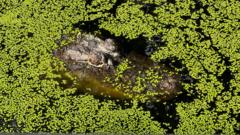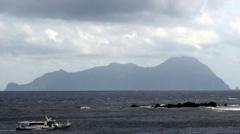The resurgence of the saltwater crocodile population in the Northern Territory poses a dilemma for locals as their aggressive nature requires careful management to ensure public safety without compromising conservation efforts. With growing tourism and economic benefits stemming from crocodile farming, authorities strive to find a balanced approach amidst fatalities and community concerns.
Crocodile Conundrum: Conservation vs. Combat in Australia's Northern Territory

Crocodile Conundrum: Conservation vs. Combat in Australia's Northern Territory
As saltwater crocodile populations rebound in Australia's Northern Territory, the government grapples with managing their numbers for public safety while preserving the species.
As dawn breaks over Darwin Harbour, the quiet yet tense atmosphere is interrupted only by the occasional splash from inside a floating trap. Government ranger Kelly Ewin, tasked with capturing and removing crocodiles, expertly balances on the precarious vessel. Heavy clouds loom overhead as he navigates the unpredictable nature of the territory's most notorious predator.
Saltwater crocodiles, commonly referred to as "salties," were nearly eradicated in the Northern Territory (NT) around 50 years ago, dwindling to a mere 3,000 due to rampant hunting for their skins. However, conservation efforts turned the tide in 1971, allowing the species' population to rebound to approximately 100,000—more than anywhere else globally. The shift has ignited a pressing debate: how to responsibly manage this abundant crocodile population to protect public safety while ensuring people continue to cohabit peacefully with these apex predators.
The NT boasts an ideal environment for saltwater crocodiles, combining hot weather with myriad waterways. Though fatal encounters are rare, incidents do occur, such as the tragic death of a 12-year-old girl last year—an event that thrust crocodile management into the spotlight. Local experts, like Professor Grahame Webb, emphasize the need for a balanced approach, advocating for education and awareness programs while monitoring populations to prevent negative interactions.
In addition to Ewin's team, whose work involves the regular maintenance of crocodile traps around Darwin, the Northern Territory government has launched initiatives like "Be Crocwise," aimed at educating locals and tourists about crocodile behavior and safety practices. With fluctuating numbers of crocodiles posing a threat, calls for controlled culling have emerged. However, the current management plan allows for an increase in the quota of crocodiles that can be culled annually, emphasizing the need to maintain a sustainable predator population rather than endangered status.
The economic implications of crocodile management cannot be overlooked. The saltwater crocodile has become a significant draw for tourists, who flock to marvel at “croc jumping” displays and partake in guided tours that showcase these iconic reptiles. The luxury leather industry has also capitalized on crocodile farming since hunting was banned, creating commercial opportunities that have proven beneficial for the local economy. Fashion brands including Louis Vuitton and Hermès rely on ethically sourced crocodile skins, further intertwining ecological stewardship with economic growth.
Despite the potential benefits, the crocodile farming industry faces criticism from animal rights activists who raise concerns regarding the treatment of crocodiles in captivity. Many captive reptiles are housed alone to prevent damage to their valuable skins, which goes against their social nature. Furthermore, community voices stress the importance of integrating Indigenous groups in conservation and commercial ventures, recognizing the cultural significance of crocodiles over centuries.
As the debate continues, the people of the Northern Territory remain divided on how to handle their infamous residents. While some advocate for more aggressive management to ensure safety, others argue for ongoing conservation efforts that prioritize education and coexistence. Ultimately, for those living in the realm of saltwater crocodiles, the challenge lies in continuing to balance human needs with the preservation of a species that is as revered as it is feared.




















